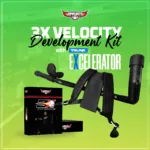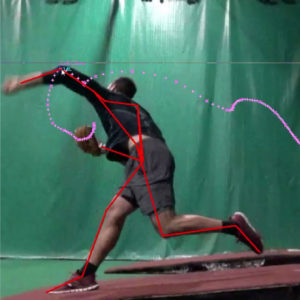 Are you looking for the answer to the question, Does Arm Speed In Pitchers Matter? Then this is the article for you!
Are you looking for the answer to the question, Does Arm Speed In Pitchers Matter? Then this is the article for you!
In the world of baseball, the pitcher stands as a pivotal figure, wielding significant influence over the game's outcome. A pitcher's arm speed is often highlighted as a key factor in their success. However, the truth about arm speed and its role in pitching efficacy and safety is complex and nuanced.
Understanding Pitching Mechanics: Does Arm Speed In Pitchers Matter?
Understanding the mechanics of pitching is crucial for any baseball player, especially pitchers who aim to optimize their performance while minimizing the risk of injury. Pitching is not just about throwing the ball; it's a complex, dynamic sequence that requires precise coordination of various body parts.
The Phases of Pitching Mechanics: Does Arm Speed In Pitchers Matter?
- Wind-Up Phase: This initial phase sets the tone for the pitch. The pitcher begins with a stance that balances them while they start the motion. This phase includes the initial movement of the arm and the gathering of momentum. It's about setting up the body in a rhythm that prepares for the explosive actions to follow.
- The Stride: Following the wind-up, the pitcher moves into the stride phase where they transition their weight from the back leg to the front leg. This movement is crucial as it generates forward momentum and aligns the body for the arm action. The stride length and mechanics can significantly affect the velocity and accuracy of the pitch.
- Arm Cocking: In this critical phase, the pitcher raises their throwing arm to an elevated position while the shoulder reaches its maximum external rotation. This is where potential energy is built up, ready to be converted into kinetic energy. Proper alignment and positioning here are vital to prevent undue stress on the shoulder joint.
- Acceleration: This is the explosive phase where the pitcher releases the energy accumulated, propelling the ball forward. The arm moves from external rotation in the shoulder to rapid internal rotation, with the elbow extending and the wrist snapping forward to add additional speed to the pitch.
- Deceleration: Immediately after the ball is released, the arm must be slowed down safely. The deceleration phase absorbs the considerable forces generated during acceleration. Muscles on the back of the shoulder and the upper back play crucial roles here, preventing the arm from continuing its forward motion in an uncontrolled manner and reducing the risk of injuries.
- Follow-Through: The final phase of the pitch ensures that the energy and motion of the body are safely dissipated. The pitcher's body continues to move forward after the ball is released, with a controlled finish that helps maintain balance and stability. Proper follow-through is essential for protecting the arm from excessive wear and helps ensure the pitcher's readiness for the next action, whether it's another pitch or a defensive move.
Importance of Coordinated Movements
Each phase of the pitching process is interconnected; a flaw in one can impact the others, potentially leading to reduced performance or injury. For example, an improper wind-up can throw off the stride, leading to less effective arm cocking and acceleration, thereby reducing the pitch's power and accuracy. Similarly, poor deceleration and follow-through can increase the stress on the pitcher's arm, leading to overuse injuries over time.
Effective pitching mechanics are not just about the arm but involve the entire body—from the legs generating force during the stride to the core stabilizing the torso during the cocking and acceleration phases. Understanding and practicing each phase's nuances can lead to improved performance and a longer, healthier career in baseball.
Significance of Arm Speed: Does Arm Speed In Pitchers Matter?
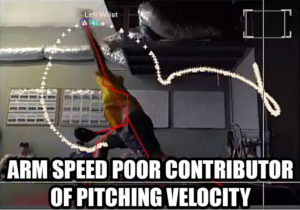 The significance of arm speed in baseball pitching is often highlighted as a critical factor for achieving high ball velocities, which is seen as a key component of an effective pitch. While it's true that arm speed can impact the speed at which a ball is thrown, the relationship between arm speed and effective pitching is more complex and nuanced than simply how fast the arm moves.
The significance of arm speed in baseball pitching is often highlighted as a critical factor for achieving high ball velocities, which is seen as a key component of an effective pitch. While it's true that arm speed can impact the speed at which a ball is thrown, the relationship between arm speed and effective pitching is more complex and nuanced than simply how fast the arm moves.
Beyond Just Speed: The Role of Efficiency and Mechanics
- Efficiency of Motion: Efficient motion is about the smooth and coordinated action of the entire body during the pitch. It’s not just the arm that needs to move quickly; the legs, hips, core, and shoulders must all work in harmony to transfer energy throughout the kinetic chain. An efficient motion ensures that the energy generated by the body is maximized and effectively transferred to the ball.
- Mechanics of the Pitch: Good pitching mechanics are crucial for ensuring that the arm speed contributes positively to the pitch. This includes the alignment of the body, the timing of the movements, and the sequence in which the body parts are engaged. Poor mechanics can not only reduce the effectiveness of the pitch but also lead to inconsistencies and increased risk of injury.
- Overall Body Utilization: The best pitchers know how to use their entire body to aid in the pitching process. This means engaging the legs and core to generate power, using the torso to add rotation and leverage, and coordinating these movements to amplify the arm's action. When the whole body works as a unit, the reliance on the arm alone for speed is reduced, enhancing both performance and durability.
The Potential Drawbacks of Excessive Arm Speed
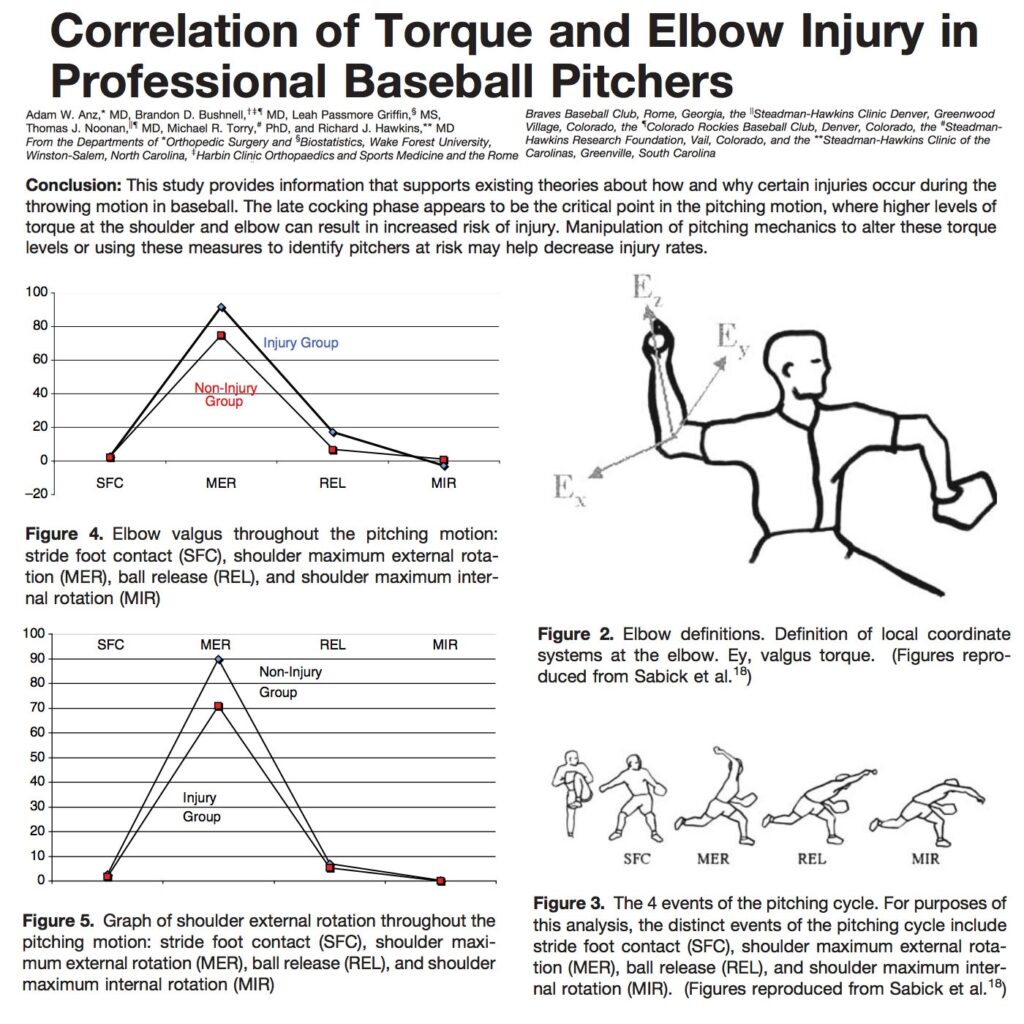
While intuitively, one might think that faster is always better when it comes to pitching, there are potential drawbacks to excessive arm speed:
- Increased Injury Risk: High arm speeds can put significant stress on the shoulder and elbow joints, particularly if the surrounding muscles are not sufficiently strong or the mechanics are flawed. This can lead to a range of injuries, from tendonitis to more severe issues like rotator cuff tears or elbow ligament injuries.
- Control and Accuracy Issues: Sometimes, pitchers who focus too much on arm speed may sacrifice control and accuracy. Being able to pitch precisely and consistently is often more valuable than the ability to throw extremely fast. Balancing speed with control is key.
- Fatigue and Sustainability: Maintaining very high arm speeds can be exhausting, especially over the course of a game or a season. Pitchers who rely heavily on their arm speed may find themselves fatiguing sooner, which can affect their performance and increase the likelihood of injury.
The Modern View of Arm Speed in Pitching
Recent studies and sports science advancements suggest that while arm speed is a component of successful pitching, it should not be isolated from other aspects of pitching technique. The focus is increasingly on developing well-rounded athletes who not only have good arm speed but also excel in mechanics, strength, and efficiency.
In conclusion, while arm speed is undoubtedly important, it is just one part of a much larger picture. Effective pitching is about the integration of speed with mechanical correctness, physical strength, and tactical intelligence. Ensuring these elements work together seamlessly is what allows pitchers to perform at their best, reduce injury risks, and maintain a longer, more successful career in baseball.
Evaluating Arm Speed Across Different Levels of Play
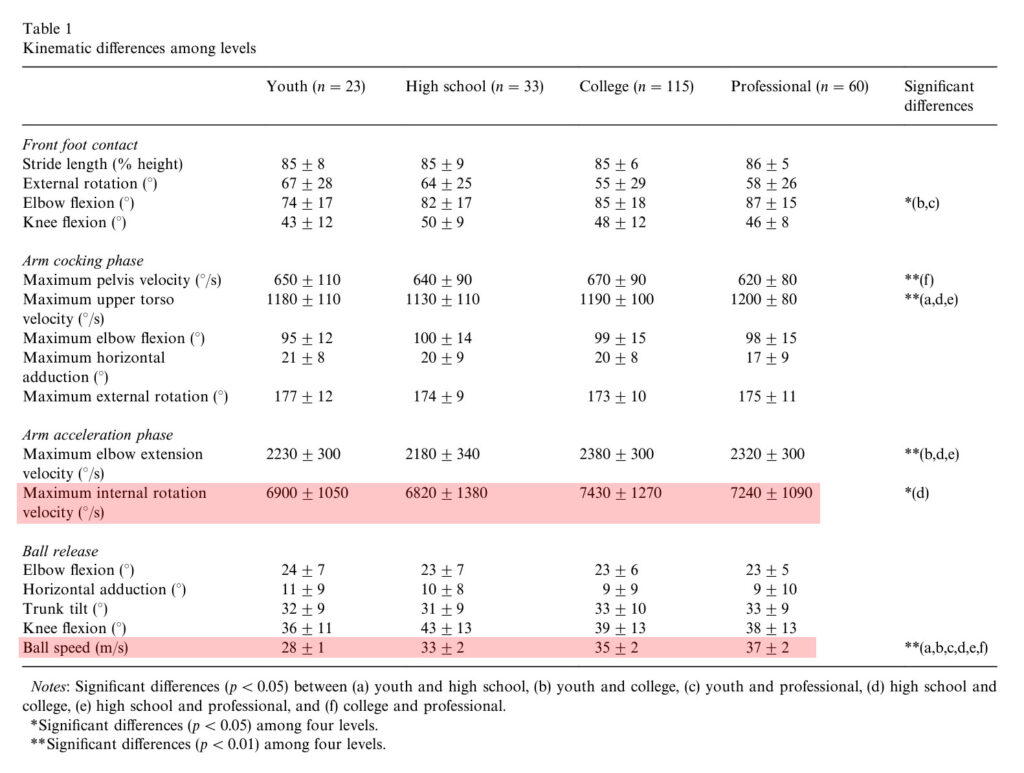
Evaluating arm speed across different levels of play provides valuable insights into the developmental aspects of pitching and highlights the adjustments needed in training and technique as pitchers progress through their careers. Understanding these changes can help coaches and athletes optimize performance and reduce injury risks.
Study Summaries and Implications: Does Arm Speed In Pitchers Matter?
Dr. Glenn S. Fleisig and others in the field have meticulously tracked how arm speeds vary among pitchers at various stages of development—from youth to the professional leagues. One of the more counterintuitive findings from these studies is that professional pitchers often exhibit lower arm speeds compared to their amateur counterparts. This observation can be attributed to several factors:
- Efficiency in Mechanics: Professional pitchers typically demonstrate more refined mechanics. They have honed their technique over years of training and competition, allowing them to achieve effective pitches with less effort in the arm speed. This efficiency is often developed through advanced coaching, biomechanical analysis, and continuous refinement of pitching mechanics.
- Optimal Energy Transfer: At higher levels of play, pitchers are better at utilizing their entire body to generate pitch velocity. This involves a more effective use of the kinetic chain—the sequence of movements involving legs, hips, torso, and arm that culminates in the pitch. By optimizing how energy is transferred from one segment to another, professional pitchers can generate significant ball velocity even with comparatively lower arm speeds.
- Longevity and Health Considerations: Maintaining slightly lower arm speeds can also be a strategic choice to reduce wear and tear on the arm and shoulder, thereby extending a pitcher’s career. Professionals have a more acute awareness of the physical demands of pitching and often adjust their mechanics to preserve their health over a long season.
Comparison of Youth, College, and Professional Pitchers
When comparing pitchers across different levels of competition, a clear evolution in pitching mechanics and arm speed is evident:
- Youth Pitchers: At this level, pitchers are often in the early stages of learning proper techniques. Their arm speeds might be inconsistent, and their overall mechanics can be less efficient. The focus at this stage is typically on development and gradually increasing the complexity of their pitching mechanics.
- College Pitchers: College-level pitchers usually have a higher arm speed as they have developed stronger muscular systems and have begun to refine their technique. However, there is still significant variation in the efficiency of their mechanics, and injury risks can be higher if proper techniques are not maintained.
- Professional Pitchers: As noted, professionals tend to have lower arm speeds but better control and efficiency. This refined control allows them to pitch effectively across longer seasons and maintain their performance as they age. Their ability to manage and modulate arm speed without sacrificing velocity is a testament to their advanced skill level and understanding of pitching mechanics.
In summary, the trajectory from youth to professional pitching underscores a shift from raw power and speed to refined mechanics and efficiency. This progression is essential for achieving peak performance and longevity in the sport. Coaches and trainers can use these insights to tailor training programs that appropriately challenge and develop pitchers at each stage, focusing on long-term development rather than short-term gains.
The Relationship Between Arm Speed, Torque, and Injury
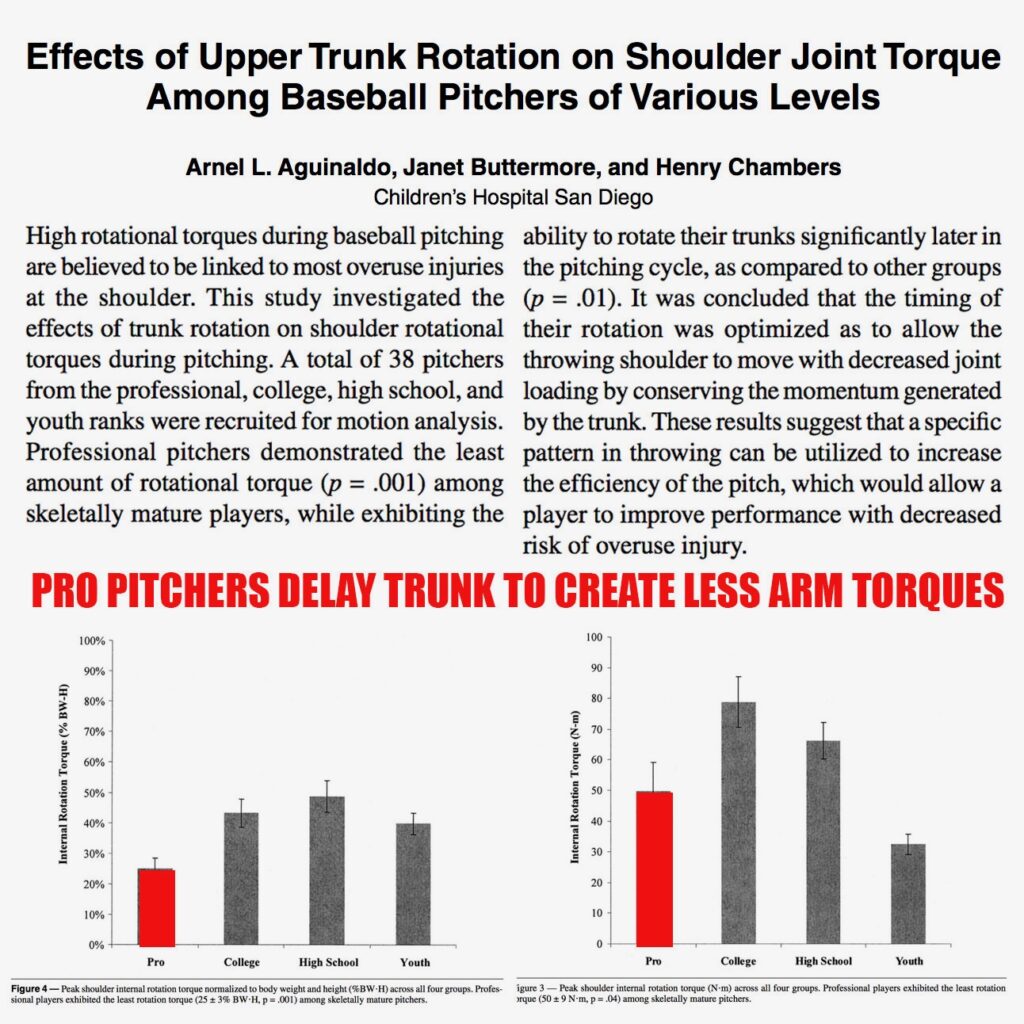
Understanding the biomechanical aspects of pitching is critical for enhancing a pitcher's career longevity and effectiveness. A crucial component of this is comprehending the relationship between arm speed, torque, and the risk of injury. This knowledge not only helps in preventing injuries but also in optimizing a pitcher's performance through better mechanics and training methods.
Torque as a Predictor of Injury: Does Arm Speed In Pitchers Matter?
Torque, the rotational force applied during the pitching motion, particularly at the shoulder and elbow joints, plays a significant role in the mechanics of pitching. High levels of torque can be indicative of high stress on these joints. Studies in sports biomechanics have consistently demonstrated a correlation between elevated torque and increased risk of injuries such as torn ligaments and tendinitis.
- Impact of Torque on the Shoulder and Elbow: During the pitching motion, especially in the acceleration and deceleration phases, the shoulder and elbow joints experience high levels of torque. At these moments, the ligaments and tendons around these joints are under immense stress, potentially leading to overuse injuries. The shoulder, being a highly mobile but less stable joint, is particularly susceptible to injuries like rotator cuff tears and labral tears.
- High Torque and Injury Mechanisms: The mechanism of injury often involves repetitive stress and overloading, which are exacerbated by high torque. For pitchers, this risk is heightened with increased arm speed, as faster arm speeds can lead to higher torque if not properly managed with correct biomechanics.
- Research Findings: Studies, such as those by renowned researchers like Dr. Glenn Fleisig, have provided empirical evidence linking high torque during pitching to a higher incidence of elbow and shoulder injuries. These studies underscore the importance of managing torque levels through improved pitching mechanics and other preventive strategies.
Strategies to Reduce Injury Risks: Does Arm Speed In Pitchers Matter?
Reducing the risk of injuries while maintaining or enhancing performance is a key goal in sports science. The following strategies, derived from research and practice, are effective in managing torque levels and reducing injury risks:
- Strengthening Exercises: Developing strength in the muscles around the shoulder, elbow, and core can help better support these joints and absorb some of the stresses associated with pitching. Exercises that target the rotator cuff, deltoids, biceps, triceps, and the scapular stabilizers are particularly beneficial.
- Adjustments in Pitching Mechanics: Optimizing pitching mechanics to reduce unnecessary torque can significantly decrease injury risks. This includes ensuring proper alignment and motion during the pitch, avoiding over-rotation of the shoulder, and ensuring the arm does not lag excessively behind the body. Techniques such as increasing trunk rotation and adjusting the timing of the pitching sequence can also help distribute the force more evenly across the body.
- Workload Management: Managing the number of pitches thrown, the frequency of pitching, and ensuring adequate rest periods are crucial for reducing the cumulative stress on a pitcher’s arm. Implementing pitch count limits, especially for younger pitchers, and monitoring fatigue levels can prevent overuse injuries.
- Regular Biomechanical Assessments: Utilizing modern technology to assess a pitcher's mechanics in real-time can provide immediate feedback that can be used to adjust techniques and prevent the development of harmful patterns. Tools like high-speed cameras, wearable sensors, and motion analysis software are increasingly accessible and provide valuable insights that can guide training and rehabilitation.
- Education and Awareness: Educating pitchers, coaches, and trainers about the risks associated with high torque and the importance of proper mechanics is fundamental. Awareness can drive the adoption of best practices in training, warm-up routines, and during games to maintain peak performance without compromising health.
In conclusion, a comprehensive approach that includes biomechanical analysis, targeted exercises, adjustments in mechanics, and strategic workload management forms the cornerstone of injury prevention in baseball pitching. By understanding and addressing the relationship between arm speed, torque, and injury, pitchers can aspire to not only prolong their careers but also enhance their performance on the mound.
Optimizing the Kinetic Chain for Enhanced Performance
alOptimizing the kinetic chain in pitching is a critical strategy for enhancing performance while minimizing the risk of injury. By understanding and improving how body segments and joints work together in a coordinated manner, pitchers can achieve greater efficiency in their pitching mechanics.
Role of the Kinetic Chain in Pitching: Does Arm Speed In Pitchers Matter?
The kinetic chain in pitching comprises a series of body segments — including the legs, hips, torso, arm, and wrist — that must act in a fluid, interconnected sequence to execute a pitch effectively. Each component in the chain contributes to the force and motion generated, culminating in the delivery of the ball.
- Energy Transfer: Efficient pitching relies on effective energy transfer along the kinetic chain. The motion typically starts in the lower body, with the legs and hips generating foundational power. This energy is then transferred through the core and torso, which amplify the force, before finally reaching the arm and hand, where the speed is maximized to deliver the pitch.
- Joint Coordination and Timing: Proper timing and coordination of movements across the joints ensure that the energy flows smoothly without any leaks or misdirections. Misalignment or poor timing can not only reduce the effectiveness of a pitch but also increase the strain on specific body parts, leading to potential injuries.
- Stress Distribution: A well-optimized kinetic chain helps distribute the physical stress of pitching across multiple body parts. This distribution is crucial for reducing the overload on the arm and shoulder, which are often the most vulnerable to injuries.
Techniques to Optimize Performance: Does Arm Speed In Pitchers Matter?
To harness the full potential of the kinetic chain, pitchers can employ several techniques and exercises that focus on strength, flexibility, coordination, and timing.
- Lower Body Strength and Power Exercises: Since the initial power in a pitch comes from the lower body, strengthening the legs and hips is fundamental. Exercises like squats, lunges, and plyometric drills can enhance lower body strength and explosive power, providing a strong base for the pitching motion.
- Core Stability and Rotation Exercises: The core acts as a bridge between the lower body and the upper body. Strengthening the core muscles, including the abdominals, obliques, and lower back, can improve the efficiency of energy transfer and rotational speed. Exercises such as Russian twists, medicine ball throws, and stability ball workouts are effective for building a robust core.
- Flexibility and Mobility Routines: Flexibility and mobility are essential for maintaining the range of motion needed in pitching and for preventing injuries. Dynamic stretches, yoga, and mobility drills can help maintain joint health and ensure that movements along the kinetic chain are fluid and unrestricted.
- Mechanical Drills and Technique Adjustments: Working with pitching coaches to refine technique can ensure that the mechanical aspects of pitching are optimized. This might involve adjustments to the pitching stance, stride length, arm path, and follow-through to ensure that all segments of the kinetic chain are properly aligned and timed.
- Video Analysis and Feedback: Utilizing video analysis tools to monitor and adjust pitching mechanics can provide valuable feedback. This technology helps identify any breakdowns or inefficiencies in the kinetic chain and allows for targeted adjustments.
- Practice and Repetition: Mastery of kinetic chain optimization comes with practice. Regular and deliberate practice focusing on technique and the integration of strength and flexibility training can engrain these elements into a pitcher's muscle memory.
Incorporating these techniques into regular training routines can help pitchers not only increase their velocity and accuracy but also pitch more sustainably with a reduced risk of injury. By fully understanding and optimizing each link in the kinetic chain, pitchers can elevate their performance to higher levels.
3X Velocity Development Kit with the Trunk Excelerator
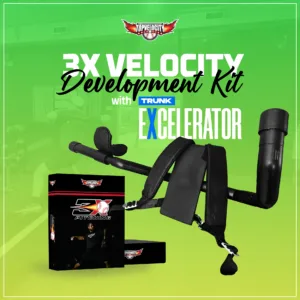 Transform your baseball performance fundamentally with the innovative 3X Velocity Development Kit, which includes the groundbreaking Trunk Excelerator. This state-of-the-art training tool from TopVelocity is specifically designed to enhance your pitching velocity by focusing on the power of the trunk, reducing the reliance on arm speed and minimizing the risk of arm injuries.
Transform your baseball performance fundamentally with the innovative 3X Velocity Development Kit, which includes the groundbreaking Trunk Excelerator. This state-of-the-art training tool from TopVelocity is specifically designed to enhance your pitching velocity by focusing on the power of the trunk, reducing the reliance on arm speed and minimizing the risk of arm injuries.
Why Choose the 3X Velocity Development Kit with Trunk Excelerator?
- Advanced Training Innovation: The Trunk Excelerator stands out as a revolutionary device that changes the game in velocity development. By emphasizing trunk mechanics and optimizing power transfer without overloading the arms, this device ensures that pitchers can achieve greater velocity through improved core strength and stability.
- Focused Trunk Development: The Trunk Excelerator encourages pitchers to use their trunk more effectively by immobilizing the arms during training. This leads to a stronger, more explosive pitching motion, directly translating into increased velocity and better control over the ball.
- Immediate Performance Enhancement: Initially, the Trunk Excelerator challenges athletes by reducing their arm use, which might temporarily lower throwing speeds. However, this innovative approach quickly leads to significant improvements in trunk function and overall pitching mechanics, often resulting in a noticeable increase in velocity as soon as the device is removed.
- Biomechanical research, such as the important study by Aguinaldo and Escamilla (2019), backs up the Trunk Excelerator's claim that it improves performance by using the trunk's role in transferring energy. The study demonstrates that optimal trunk motion is crucial for maximizing pitching velocity, with the trunk contributing to a significant portion of the energy transfer in a pitch.
- Comprehensive Training Package: Alongside the Trunk Excelerator, the 3X Velocity Development Kit includes a detailed training program with drills, exercises, and step-by-step guidance. This package equips athletes with the knowledge and tools necessary to refine their skills, increase their velocity, and prevent injuries.
Elevate Your Game with TopVelocity
Whether you're aiming to enhance your pitching skills or improve your overall athletic performance, the 3X Velocity Development Kit with Trunk Excelerator provides a comprehensive solution. It’s ideal for pitchers who want to dominate the game and field players looking to boost their throwing power.
Your Path to Elite Performance
Embrace the opportunity to revolutionize your approach to baseball training. The 3X Velocity Development Kit with Trunk Excelerator offers a scientifically backed, innovative method to increase your pitching velocity while fostering long-term athletic development and injury prevention.
Take Action Now
Don’t wait to take your performance to the next level. Visit TopVelocity.net/tx to order your 3X Velocity Development Kit with Trunk Excelerator today. Start your journey towards achieving peak velocity and becoming a standout athlete on the field. Make the smart investment in your baseball career with TopVelocity’s proven training solutions!



